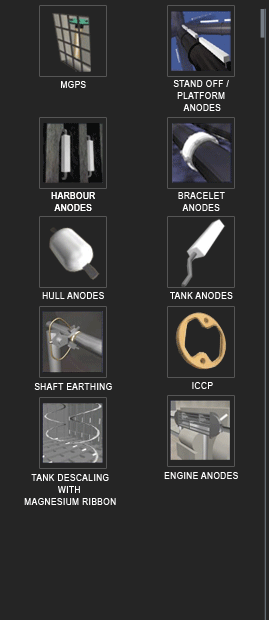
Marine Growth Prevention Sytem (MGPS)
A common method of fouling prevention in emergency fire intakes and vessels seawater cooling systems is the Impress Current Anti-fouling system (ICAF) commonly referred to as the Marine Growth Prevention System (MGPS), which usually consists of two types of anodes, a Copper alloy rod to prevent marine fouling and Aluminium or Ferrous alloy rod to reduce corrosion and a transformer/rectifier controller power unit. The types and sizes of these anodes arespecified according to design parameters which allow for the maximum flow rate encountered during sea-going service and system life.
Specially formulated Copper alloyed anodes are used to prevent marine fouling found in pipe work strainers, heat exchangers, pumps, box coolers that cause blockage and accelerate corrosion and operate in certain open water applications. Fouling is not killed and the systems designed at 2ppb are not damaging to the environment. There are available in a variety of sizes and MCPS can offer equivalent anodes of all competitors.
Aluminium and Ferrous Alloyed rods are used to mitigate corrosion. Aluminium alloyed anodes are used in conjunction with copper alloyed anodes to prevent corrosion throughout ferrous pipe work. Ferrous-alloyed anodes are used in conjunction with copper alloyed anodes to prevent corrosion throughout Cu/Ni pipe work. They are available in a variety of sizes and MCPS can offer equivalent anodes of all competitors.
This type of MGPS relies on an external direct current source to be forced into the water from wasting anodes. The anode is in the electrolyte with the sea chest/strainer it intends to protect, and is made more positive than the structure by connecting the DC supply to both the anode and the structure. Cupric Ions are produced from the anti-fouling anode, and once fitting will quickly remove existing marine growth and can be used in seawater suctions and open water applications.
The anodes are insulated from the hull/sea chest and are surrounded by heat shrink to prevent necking of the anodes and premature consumption. All types of anodes are provided with a cofferdam, incorporating a double gland assembly that are required by the Classification Societies, to ensure a watertight hull penetration for the anode cable.
The electrical power is taken from the main AC power, through the transformer/rectifier controller power unit, providing a low voltage DC output to the anodes. The Controller Power Unit is self-contained in a cabinet situated in the engine room or other convenient space. It includes solid state circuitry with PCB for easy maintenance.
Full electrical protection is provided on input whilst output fuses are fitted in each anode circuit. All components are readily accessible within the drip proof steel enclosure.


